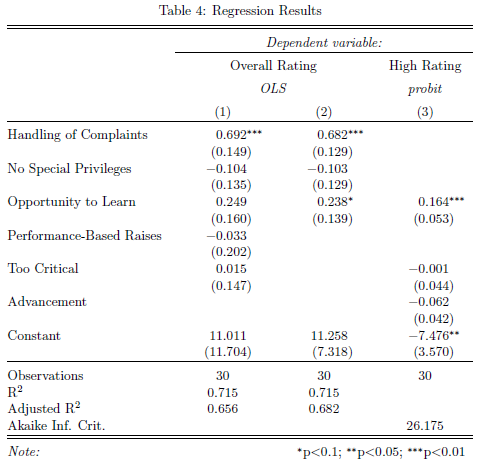Want to share your content on R-bloggers? click here if you have a blog, or here if you don't.
Guest post by Marek Hlavac
Since its first introduction on this blog, stargazer, a package for turning R statistical output into beautiful LaTeX and ASCII text tables, has made a great deal of progress. Compared to available alternatives (such as apsrtable or texreg), the latest version (4.0) of stargazer supports the broadest range of model objects. In particular, it can create side-by-side regression tables from statistical model objects created by packages AER, betareg, dynlm, eha, ergm, gee, gmm, lme4, MASS, mgcv, nlme, nnet, ordinal, plm, pscl, quantreg, relevent, rms, robustbase, spdep, stats, survey, survival and Zelig. You can install stargazer from CRAN in the usual way:
install.packages(“stargazer”) |
New Features: Text Output and Confidence Intervals
In this blog post, I would like to draw attention to two new features of stargazer that make the package even more useful:
- stargazer can now produce ASCII text output, in addition to LaTeX code. As a result, users can now create beautiful tables that can easily be inserted into Microsoft Word documents, published on websites, or sent via e-mail. Sharing your regression results has never been easier. Users can also use this feature to preview their LaTeX tables before they use the stargazer-generated code in their .tex documents.
- In addition to standard errors, stargazer can now report confidence intervals at user-specified confidence levels (with a default of 95 percent). This possibility might be especially appealing to researchers in public health and biostatistics, as the reporting of confidence intervals is very common in these disciplines.
In the reproducible example presented below, I demonstrate these two new features in action.
Reproducible Example
I begin by creating model objects for two Ordinary Least Squares (OLS) models (using the lm() command) and a probit model (using glm() ). Note that I use data from attitude, one of the standard data frames that should be provided with your installation of R.
## 2 OLS models linear.1 <- lm(rating ~ complaints + privileges + learning + raises + critical, data=attitude) linear.2 <- lm(rating ~ complaints + privileges + learning, data=attitude) ## create an indicator dependent variable, and run a probit model attitude$high.rating <- (attitude$rating > 70) probit.model <- glm(high.rating ~ learning + critical + advance, data=attitude, family = binomial(link = "probit")) |
I then use stargazer to create a ‘traditional’ LaTeX table with standard errors. With the sole exception of the argument no.space – which I use to save space by removing all empty lines in the table – both the command call and the resulting table should look familiar from earlier versions of the package:
stargazer(linear.1, linear.2, probit.model, title="Regression Results", align=TRUE, dep.var.labels=c("Overall Rating","High Rating"), covariate.labels=c("Handling of Complaints","No Special Privileges", "Opportunity to Learn","Performance-Based Raises","Too Critical","Advancement"), omit.stat=c("LL","ser","f"), no.space=TRUE) |
In the next table, I limit myself to the two linear models, and report 90 percent confidence intervals (using the ci and ci.level arguments). In addition, I use the argument single.row to report the coefficients and confidence intervals on the same row.
stargazer(linear.1, linear.2, title="Regression Results",
dep.var.labels=c("Overall Rating","High Rating"),
covariate.labels=c("Handling of Complaints","No Special Privileges",
"Opportunity to Learn","Performance-Based Raises","Too Critical","Advancement"), omit.stat=c("LL","ser","f"), ci=TRUE, ci.level=0.90, single.row=TRUE) |
To produce ASCII text output, rather than LaTeX code, I can simply set the argument type to “text”:
stargazer(linear.1, linear.2, type="text", title="Regression Results",
dep.var.labels=c("Overall Rating","High Rating"),
covariate.labels=c("Handling of Complaints","No Special Privileges",
"Opportunity to Learn","Performance-Based Raises","Too Critical","Advancement"), omit.stat=c("LL","ser","f"), ci=TRUE, ci.level=0.90, single.row=TRUE) |
What Else is New?
The two new features that I have focused on in this blog post, of course, do not exhaust the range of innovations that the new stargazer brings. The package can now output beautiful LaTeX and ASCII text tables directly into .tex and.txt files, respectively, using the out argument.
Additionally, users have a greater scope for making changes to the table’s formatting. A much-demanded addition to version 4.0 concerns column labels. Using arguments column.labels and column.separate, users can now add a label to each of the columns in their regression table. Such labels can be used to indicate, among other things, the sub-sample or research hypothesis that a particular column refers to. In addition, users can also change the caption above the names of the dependent variables (argument dep.var.caption), as well as tinker with the size in the resulting table (argument .size).
More advanced users can now choose whether the LaTeX table should be enclosed within a floating environment (arguments float and float.env), and where the resulting table should be placed within the LaTeX document (argument table.placement). In this way, they might, for example, create a LaTeX table that is rotated by 90 degrees (when float.env = “sidewaystable”).
Marek Hlavac is a doctoral student in the Political Economy and Government program at Harvard Unviersity. If you have any suggestions for future versions of the stargazer package, please contact him at hlavac@fas.harvard.edu .
R-bloggers.com offers daily e-mail updates about R news and tutorials about learning R and many other topics. Click here if you're looking to post or find an R/data-science job.
Want to share your content on R-bloggers? click here if you have a blog, or here if you don't.

